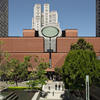More about Prickle, the Clown
- All
- Info
- Shop

Contributor
Sad Prickle, the Clown looks as though this poor guy attended an acupuncture appointment gone horribly wrong.
This etching is just one example of Paul Klee’s imaginative renderings of already creepy things in even creepier situations. Throughout his career, Klee appears to be driven by the idea of play and entertainment, creating puppets, masks and drawings that reflect a fascination with the theater, opera and circus. Ultimately, Klee had a slight Peter Pan complex, his art driven by a fascination with the idea of shifting and transformative identities apparent in children’s play. In fact, many of Klee’s toys and etchings were made for his son but honestly, if his son didn’t fear clowns before, the likes of Prickle may well have launched him into that phobia.
All this leads right back to our dear Stachel, der Clown. Not only does he appear like a humanoid pin cushion, but his shape and placement of the pins transforms him into so much more than just a slightly disturbing looking clown. His face could be a farmhouse surrounded by hay with windmills floating off the back of his head and a silo beacon as his hat. But, the best part is, Klee was all about the imagination so you can see past the disconcerting clown expression and see anything your mind can conjure up! Even with a seemingly specific title, Stachel’s identity is subject to change with each viewer, constantly shifting and experimenting with how he can be seen.
Sources
- Rachel Jans, “Paul Klee at Play”, San Francisco, San Francisco Museum of Modern Art, 20 February 2017.












